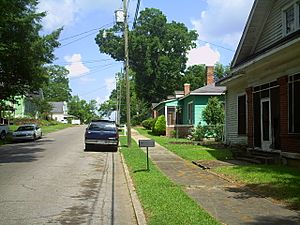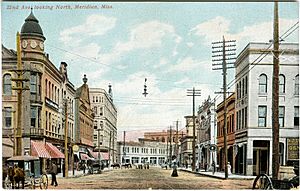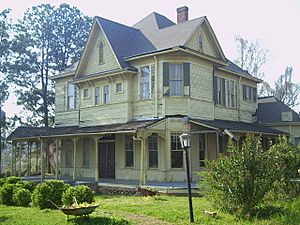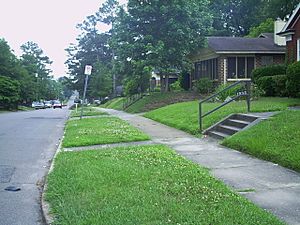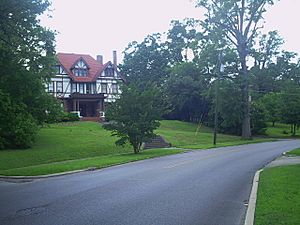Historic districts in Meridian, Mississippi facts for kids
- 1 East End Historic District
- 2 Highlands Historic District
- 3 Meridian Downtown Historic District
- 4 Meridian Urban Center Historic District
- 5 Union Station Historic District
- 6 Merrehope Historic District
- 7 Mid-Town Historic District
- 8 Poplar Springs Road Historic District
- 9 West End Historic District
Meridian, Mississippi, is home to nine special areas called historic districts. These districts are like outdoor museums, protecting old buildings and places that are important to history. Each one is listed on the National Register of Historic Places, which means they are recognized as valuable parts of American history.
These districts show off many different building styles, mostly from the late 1800s and early 1900s. You can see styles like Queen Anne, Colonial Revival, Italianate, Art Deco, and Bungalow. One of the districts, the Meridian Downtown Historic District, was created by joining two older ones: the Meridian Urban Center Historic District and the Union Station Historic District.
Contents
East End Historic District
The East End Historic District is a large area, about 970-acre (3.9 km2) big. It was added to the National Register of Historic Places in 1987. This district is special because it has many beautiful Queen Anne and Colonial Revival style homes. These houses were built between 1890 and 1910, during a time called Meridian's "Golden Age."
About 60% of the buildings here are from this period. They show how fast Meridian grew eastward after the American Civil War. This growth happened because the city's transportation, factories, and businesses were booming.
Richard McLemore, one of Meridian's founders, had a cotton plantation in this area. In 1839, he started a cemetery, which is now McLemore Cemetery. It's the oldest historic site left in Meridian. Later, in 1853, another founder named Lewis Ragsdale bought much of McLemore's land. He divided it into smaller plots, which led to many homes being built in this district.
Sixteenth Avenue became a very important road because of textile and planing businesses along a streetcar line. It was even the first paved street in the city!
Some key buildings in this district include:
- – A one-story wooden house in the Queen Anne style.
- – A one-and-a-half-story wooden house in the Gothic Revival style.
Highlands Historic District
The Highlands Historic District, also known as "Red Line," covers about 220-acre (0.89 km2). It was added to the National Register of Historic Places in 1987. This area was once called Missouri Ridge because Union soldiers camped here during the Civil War.
The district really started to grow when Meridian's streetcar system began in 1883. A streetcar line, known as the "Red Line," ran through this area. It made it easy for people to travel, helping the neighborhood develop.
Most of the buildings in this district are homes, over 90% of them! You'll also find a few churches, a daycare, and a convenience store. Many homes are early 1900s cottages with porches. While most were built around 1900, some date from the late 1890s to the early 1930s. You can see styles like Queen Anne, Eastlake, and Colonial Revival. Some porches were even updated in the 1920s with the American Craftsman architecture style.
Important buildings in this district include:
- – A two-story wooden house in the Queen Anne style.
- – A one-story wooden house in the Queen Anne style.
Meridian Downtown Historic District
The Meridian Downtown Historic District is a big area that became one district in 2005. It combined two older districts: the Meridian Urban Center Historic District and the Union Station Historic District. This large new district was added to the National Register of Historic Places in 2007.
Meridian's downtown used to have a main business area and a factory zone. The business part was the old Urban Center, and the factory part was the Union Station district. The buildings here show almost the entire history of the city, from around 1870 to the mid-1950s.
These buildings tell stories of economic growth, like when Meridian became a big city in the 1880s. They also show the transportation boom when Union Station was built in 1906. You can see how the city handled tough times like the Great Depression and kept growing in the 1940s and 1950s. Architectural styles here include Italianate, Spanish Colonial Revival, Romanesque, Art Deco, and simpler commercial styles.
The western part of downtown has strong ties to the African-American community. Important businesses like the E. F. Young Hotel and the Fielder and Brooks Drug Store were here. A COFO office was even located in the drug store during the American Civil Rights Movement in the 1960s.
Some important buildings in this district that are also listed on the National Register include:
-
 Union Hotel (2000 Front St)
Union Hotel (2000 Front St) -
 Alex Loeb Building (2115 5th St)
Alex Loeb Building (2115 5th St) -
Lamar Hotel (410 21st St)
-
Threefoot Building (601 22nd Ave)
Other notable buildings here are:
-
Soulé Steam Feed Works Machine Shop Annex (1804 4th St)
Merrehope Historic District
The Merrehope Historic District is a uniquely shaped area, about 350-acre (1.4 km2). It was added to the National Register of Historic Places in 1988. The buildings here were built from the late 1880s to about 1940. They show Meridian's "Golden Age" and highlight the history of the African-American community during that time.
This area was first divided into plots around 1853 by city founder John T. Ball. But it really started to grow after the American Civil War. Meridian's economy boomed with railroads, logging, and textile businesses. As the city grew north, more homes were needed.
The Meridian streetcar system, started in 1883, helped people move to the city's edges and commute to work. Before this, most people lived downtown, close to their jobs. The streetcar made it possible for "hundreds of families who had for years remained in cramped quarters" to spread out.
Much of this district, especially the northern part, was home to middle-class African Americans. In 1908, Black residents owned over fifty businesses in the city. Many were lawyers, doctors, teachers, and nurses, and many lived in the Merrehope District.
The district's strong connection to the Black community is seen in its important buildings. A Black fire company was here from 1884 to 1903. Two Black churches, First Baptist Church and St. Paul United Methodist Church, were built in the late 1800s. The Carnegie library built for African Americans in Meridian was the only Carnegie library for Black people in the entire country. The Masonic Temple, built in 1903, was owned by three Black fraternal groups. It showed the strong business spirit of the Black community.
Five buildings in this district are also listed separately on the National Register:
-
Elson-Dudley House (1101 29th Ave)
- Dial House (1003 30th Ave)
-
Merrehope Historical Home (905 31st Ave)
- Carnegie Branch Library (2721 13th St)
Other important buildings still standing include:
- – A two-story wooden house in the Mediterranean style with a pyramid roof. It was built in 1915 by M. R. Grant.
- – A two-story house in the Queen Anne style.
- – A one-story Queen Anne style cottage.
- – A one-story Queen Anne style house.
- – A Queen Anne style cottage built in the 1890s.
- – A two-story Mediterranean-style building from 1909. It was the first music school in the state to get a charter.
- – A two-story Queen Anne style cottage built in the 1880s.
- – Located on the same property as Merrehope. Built in 1886, it's a great example of Queen Anne Style architecture with stained glass and detailed woodwork. It was named a Mississippi Landmark in 1995.
Mid-Town Historic District
The Mid-Town Historic District is a large area, about 1,020-acre (4.1 km2). It was added to the National Register of Historic Places in 1987. This district has many important homes from the 1900s. These houses belonged to Meridian's wealthy industrialists, professionals, and merchants, as well as the working class during the city's "Golden Age." At that time, Meridian was the center of Mississippi's railroad economy.
Most of the buildings (90%) in this district were built between 1900 and 1930. Many are in the Bungalow style. This district has a lot of brick buildings, which were an alternative to the popular wooden homes. Twenty-third and 24th Avenues were main roads connecting downtown to the northern part of the city, making them popular places for builders.
A key building in this district is:
- – A two-and-a-half-story Colonial Revival house.
Poplar Springs Road Historic District
The Poplar Springs Road Historic District covers about 820-acre (3.3 km2). It was added to the National Register of Historic Places in 1987. This district has many homes that show how prosperous Meridian was around 1900 and before the Great Depression.
Before it was a street, Poplar Springs Road (now Poplar Springs Drive) was a cattle trail. Around 1900, cattle would use this curvy path to get to a spring north of Meridian. That's why the street doesn't follow the usual city grid pattern.
In 1905, a local lumberman named M. R. Grant created a plan for side streets and lots along Poplar Springs Road. He called it Marion Park, named after his daughter. One of the city's first hospitals, Matty Hersee, was built here in 1903. It later moved, and the original building is gone. Marion Park School was built in 1923 and later became the current Meridian High School.
As this new residential area grew, many people moved north and built the homes you see today. A streetcar brought passengers from downtown Meridian to the Poplar Springs area. The old streetcar stop is even marked by a banner. Hundreds of shade trees were planted, making the streets beautiful.
Important buildings in this district include:
- – A one-story Craftsman Bungalow.
- – A one-and-a-half-story Queen Anne style cottage.
- – A one-and-a-half-story Queen Anne/Colonial Revival house.
- – A two-and-a-half-story Tudor Revival house.
- – A two-story Mission Revival style house.
- – A two-story Mission Revival style house.
West End Historic District
The West End Historic District covers about 590 acres (2.4 km2). It was added to the National Register of Historic Places in 1987. The buildings here, from 1870 to 1936, show how Meridian grew from being destroyed during the American Civil War to becoming Mississippi's largest city. The city's steady economic growth helped this district expand.
The history of this district goes back to Meridian's earliest days. But it's most important for its many homes built between 1890 and 1910. You can find long rows of historic buildings from this time throughout the district. A typical home here is a Queen Anne cottage with a steep roof and a porch updated in the Craftsman style.
Two of Meridian's oldest homes are in this district: a Greek Revival mansion built around 1870 at 2721 7th St, and an Italianate building from 1876 at 2907 7th St.
The West End grew as lumbermen, factory workers, and railroaders moved west. Many of these new residents were Irish Catholics from a small community called Paulding, which became part of the city. This area was even called "Irish Alley." It was served by St. Patrick's Roman Catholic Church and a Catholic convent, which is no longer there.
An important building still standing in this district is:
- – A two-story Italianate building.
Images for kids
-
Union Station in Meridian.


